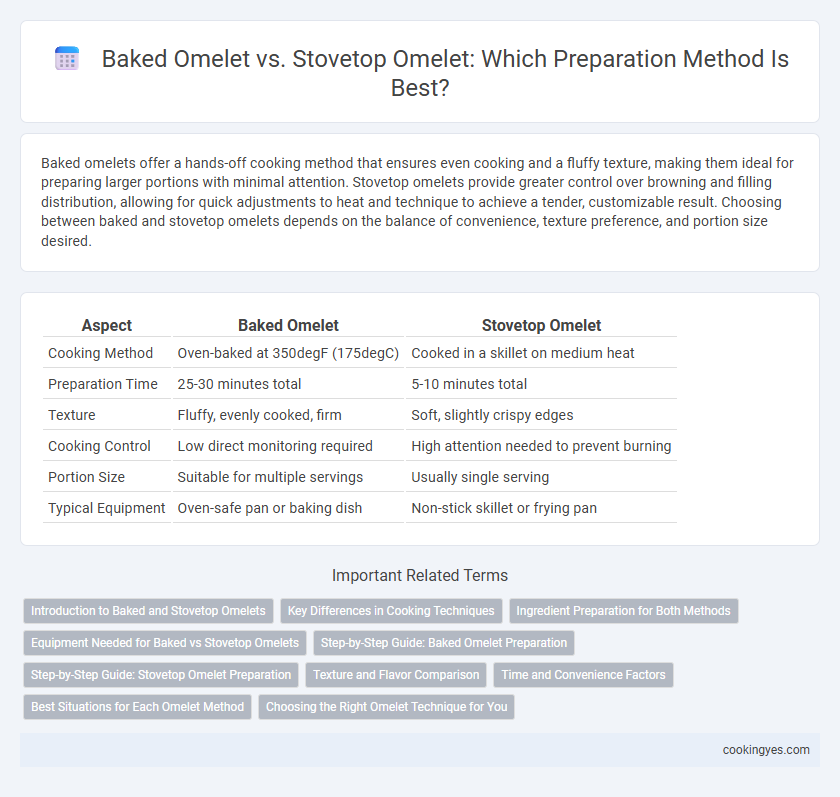Baked omelets offer a hands-off cooking method that ensures even cooking and a fluffy texture, making them ideal for preparing larger portions with minimal attention. Stovetop omelets provide greater control over browning and filling distribution, allowing for quick adjustments to heat and technique to achieve a tender, customizable result. Choosing between baked and stovetop omelets depends on the balance of convenience, texture preference, and portion size desired.
Table of Comparison
| Aspect | Baked Omelet | Stovetop Omelet |
|---|---|---|
| Cooking Method | Oven-baked at 350degF (175degC) | Cooked in a skillet on medium heat |
| Preparation Time | 25-30 minutes total | 5-10 minutes total |
| Texture | Fluffy, evenly cooked, firm | Soft, slightly crispy edges |
| Cooking Control | Low direct monitoring required | High attention needed to prevent burning |
| Portion Size | Suitable for multiple servings | Usually single serving |
| Typical Equipment | Oven-safe pan or baking dish | Non-stick skillet or frying pan |
Introduction to Baked and Stovetop Omelets
Baked omelets are prepared by mixing eggs with various ingredients and cooking the mixture evenly in an oven, resulting in a fluffy, souffle-like texture. Stovetop omelets require cooking beaten eggs in a hot pan, allowing for quick cooking with crispy edges and a tender center. Both methods offer flexibility in fillings, but baked omelets are often preferred for serving larger portions while stovetop omelets provide greater control over cooking time and texture.
Key Differences in Cooking Techniques
Baked omelets use an oven to cook evenly through gentle, consistent heat, resulting in a fluffier texture and hands-off preparation, while stovetop omelets require direct heat and constant attention to achieve a tender, slightly crispy edge. The oven's surrounding heat allows for a slower, more controlled cooking process, preventing burning and enabling easy incorporation of fillings. In contrast, stovetop omelets demand careful timing and flipping skills to avoid undercooked centers or overcooked surfaces.
Ingredient Preparation for Both Methods
Baked omelets require thorough mixing of eggs and all ingredients, including vegetables, cheese, and meats, before pouring the mixture into a baking dish, ensuring even distribution and consistent cooking. Stovetop omelets often involve separately sauteing fillings like onions, peppers, and mushrooms before adding beaten eggs directly into the pan, allowing for precise control over ingredient texture and layering. Ingredient preparation for baked omelets emphasizes uniform blending, while stovetop methods focus on individual component cooking to enhance flavor and texture.
Equipment Needed for Baked vs Stovetop Omelets
Baked omelets require an oven-safe dish such as a casserole dish or ramekins, and often a baking sheet to handle even heat distribution, making them ideal for precise temperature control. Stovetop omelets need only a non-stick skillet or frying pan and a spatula, allowing for quick, hands-on cooking with direct heat. Each method's equipment influences ease of preparation and texture, with baked omelets offering a fluffier consistency and stovetop omelets delivering a quicker, slightly crisp exterior.
Step-by-Step Guide: Baked Omelet Preparation
Baked omelet preparation begins by preheating the oven to 350degF (175degC) and greasing a baking dish or ramekins. In a mixing bowl, whisk eggs with milk, salt, and preferred seasonings before pouring the mixture into the prepared dish. Bake for 20-25 minutes until the eggs are set and lightly golden, allowing even cooking and minimal stirring compared to stovetop omelets.
Step-by-Step Guide: Stovetop Omelet Preparation
Start by whisking eggs with salt and pepper until smooth, then heat a non-stick skillet over medium heat and melt butter evenly. Pour the egg mixture into the skillet, cooking without stirring until edges begin to set, then add desired fillings like cheese, vegetables, or meats. Fold the omelet in half carefully and cook for another minute before sliding it onto a plate for serving.
Texture and Flavor Comparison
Baked omelets offer a fluffier, more uniform texture due to even heat distribution in the oven, resulting in a light and tender bite. Stovetop omelets provide a more varied texture with a slightly crispy edge and a tender center, enhancing the contrast in each mouthful. Flavor-wise, baked omelets develop a subtle caramelization and melded taste from slow cooking, while stovetop omelets deliver a fresher, more distinct egg and filling flavor from quicker cooking.
Time and Convenience Factors
Baked omelets require 15-20 minutes in the oven, offering hands-off cooking that frees time for multitasking, making them convenient for meal prep. Stovetop omelets cook quickly in about 5 minutes, providing faster results but demand active attention and skill to achieve the perfect fold and texture. For those prioritizing time efficiency and ease, stovetop omelets excel, while baked omelets suit cooks seeking convenience and consistent doneness without constant monitoring.
Best Situations for Each Omelet Method
Baked omelets excel in serving large groups and require minimal hands-on attention, making them ideal for meal prepping or brunch gatherings. Stovetop omelets offer precise control over texture and filling customization, perfect for quick, single servings or when a fluffy, tender consistency is desired. Choosing between baked and stovetop methods depends on time, portion size, and desired omelet texture.
Choosing the Right Omelet Technique for You
Baked omelets offer a hands-off cooking approach, evenly cooking the eggs in the oven and allowing for easy customization with vegetables, cheese, and meats folded in before baking. Stovetop omelets provide quicker preparation with more control over texture and doneness, enabling you to cook fillings like mushrooms or herbs directly in the pan. Choosing between baked and stovetop omelets depends on your preferred cooking style, time considerations, and desired texture.
Baked Omelet vs Stovetop Omelet for Preparation Infographic

 cookingyes.com
cookingyes.com